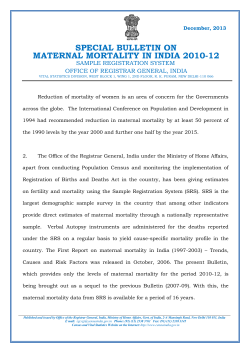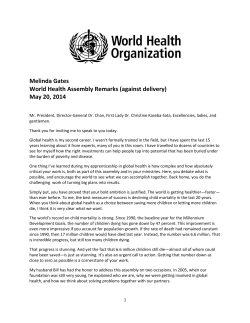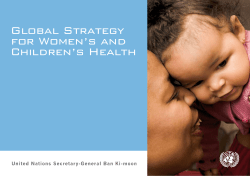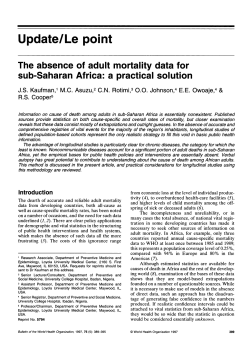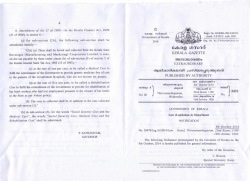
Maternal & Child Mortality and Total Fertility Rates Sample Registration System (SRS)
Maternal & Child Mortality and Total Fertility Rates Sample Registration System (SRS) Office of Registrar General, India 7th July 2011 Sample Registration System (SRS) – An Introduction • Sample Registration System (SRS) is designed for reliable estimates of fertility and mortality indicators at State and National level separately for rural and urban areas • The only source for fertility and mortality data since 1969-70 • Largest demographic survey in the country covering about 1.4 million households and 7.01 million population in 7597 sample units across 35 States/UTs • Since 2004, a system of collection of Causes of Death data through Verbal Autopsy has also been included under the domain of SRS • This system allows for tracking Millennium Development Goals (MDG) on Child Mortality & Maternal Health on a regular basis Millennium Development Goals (MDG) • MDGs are a set of numerical & time-bound targets to measure achievements in human and social development laid down by the UN. • Of the 8 MDGs, IMR, U5MR and MMR are generated by SRS. Goal No. 5 Indicators Targets by 2015 Improve maternal health Maternal Mortality Ratio (MMR) 109 Reduce infant mortality Infant Mortality Rate (IMR) 28 Reduce child mortality Under 5 Mortality Rate (U5MR) 42 Goals 4 MATERNAL MORTALITY RATIO (MMR) Maternal Mortality Ratio (MMR); India, EAG & Assam, Southern States and Other States, 2004-06 and 2007-09 MMR 2004-06 MMR 2007-09 INDIA TOTAL 254 212 Assam 480 390 Bihar/Jharkhand 312 261 Madhya Pradesh/Chhattisgarh 335 269 Orissa 303 258 Rajasthan 388 318 Uttar Pradesh/Uttarakhand 440 359 EAG AND ASSAM SUBTOTAL 375 308 Andhra Pradesh 154 134 Karnataka 213 178 95 81 Tamil Nadu 111 97 SOUTH SUBTOTAL 149 127 Gujarat 160 148 Haryana 186 153 Maharashtra 130 104 Punjab 192 172 West Bengal 141 145 Other 206 160 174 149 India & Major States Kerala OTHER SUBTOTAL MMR measures number of women aged 15-49 years dying due to maternal causes per 1,00,000 live births. MMR estimates 2007-09: Highlights • Decline in MMR estimates in 2007-09 over 2004-06: – – – – For India: 212 from 254 (a fall of about 17%) In Empowered Action Group (EAG) states & Assam: 308 from 375 (18%) Among Southern States: 127 from 149 (15%) In Other States: 149 from 174 (14%) • States realizing MDG target of 109 have gone up to 3 with Tamil Nadu & Maharashtra (new entrants) joining Kerala • Andhra Pradesh, West Bengal, Gujarat and Haryana are in closer proximity to achieving the MDG target. Trends in Maternal Mortality Ratio - India 2007-09 SRS 212 (2004-06) 63 000 (2007-09) 2009 Levels of MMR by Regions, 2007-09 Region MMR Life time risk % share of female Popln. % to total maternal deaths EAG states 308 1.1% 48.0 61.6 Southern states 127 0.3% 21.0 11.4 Other states 149 0.4% 31.0 27.0 India 212 0.6% 100 100 Levels of MMR by Regions, 1999-2009 500 450 461 438 400 375 350 327 300 301 308 33% 212 35% 149 127 35% 38% 254 250 200 Decline over last 10 years 229 206 199 173 150 174 149 100 1999-2001 India 2001-03 EAG & Assam States 2004-06 Southern States 2007-09 Other States INFANT MORTALITY RATE (IMR) IMR estimates 2009: Highlights • IMR measures number of infant( < 1 year) deaths per 1000 live births. • Every 6th death in the country pertains to an infant • IMR in India has registered a 3 points decline to 50 from 53 in 2008 • Maximum IMR in Madhya Pradesh (67) and minimum IMR in Kerala (12) • Neo-Natal Mortality Rate (<29 days) and Post Neo-Natal Mortality Rate (1 months to 11 months) has declined by 1 point and 2 points respectively • Kerala (12) & Tamil Nadu (28) have achieved the MDG target (28 by 2015) • Delhi (33), Maharashtra (31) and West Bengal (33) are in close proximity Infant Mortality Rate (IMR) by residence, 1990–2009 90 80 70 60 50 40 30 86 80 50 1990 80 74 74 68 48 64 58 44 1995 40 2000 Total Rural 2005 55 50 34 2009 Urban • IMR for the country declined by 30 points (rural IMR by 31 points vis-à-vis urban IMR 16 points) in the last 20 years at an annual average decline of 1.5 points • Still, 1 in every 20 children - National level 1 in every 18 children - rural area, and 1 in every 29 children - urban area die within one year of birth (against 1 in 37 under MDG) Infant Mortality Rate (IMR) by sex, 1990–2009 85 80 81 80 78 76 74 75 73 70 68 67 69 65 61 60 58 56 55 50 49 50 52 45 1990 1995 2000 Total Male 2005 2009 Female • Female infants continue to experience a higher mortality than male infants UNDER 5 MORTALITY RATE (U5MR) U5MR estimates 2009: Highlights • U5MR denotes number of children (0-4 years) who died before reaching their fifth birthday per 1000 live births • U5MR for the country has declined by 5 points over 2008 (64 in 2009 against 69 in 2008) • A uniform decline of about 5 points is seen in male and female U5MRs. • Maximum in Madhya Pradesh (89) and minimum in Kerala (14) • Kerala (14), Tamil Nadu (33), Maharashtra (36), Delhi (37) & West Bengal (40) have already achieved the MDG target (42 by 2015) Under 5 Mortality Rate (U5MR) by residence, 1990–2009 140 120 128 118 100 80 71 60 111 97 98 85 85 77 67 55 49 40 71 64 41 20 1990 1995 2000 Total Rural 2005 2009 Urban • U5MR for the country declined by 54 points (rural IMR by 57 points vis-à-vis urban IMR 30 points) in the last 20 years at an annual average decline of 2.7 points • Urban U5MR has already achieved the MDG target (42 by 2015) • Rural U5MR is still 71 Under 5 Mortality Rate (U5MR) by sex, 1990–2009 126 130 120 110 118 110 110 97 100 96 95 85 84 90 77 80 82 72 70 64 60 69 60 50 1990 1995 2000 Total Male 2005 2009 Female • Male-female mortality differential has narrowed down over the years, yet the gap remains significant “ Child deaths are falling, but not quickly enough to reach the MDG target” TOTAL FERTILITY RATE (TFR) Total Fertility Rate (TFR) estimates 2009: Highlights • TFR measures average number of children born to a woman during her entire reproductive period • TFR for the country remained stationery at 2.6 during 2008 to 2009 • Bihar reported the highest TFR (3.9) while Kerala and Tamil Nadu, the lowest (1.7) • Replacement level TFR, viz 2.1, has been attained by Andhra Pradesh (1.9), Delhi (1.9), Himachal Pradesh (1.9), Karnataka (2.0), Kerala (1.7), Maharashtra (1.9), Punjab (1.9), Tamil Nadu (1,7) & West Bengal (1.9) • At present, a rural woman (having a TFR of 2.9) at the National level would have about one child more than an urban woman (having a TFR of 2.0), on average Total Fertility Rate (TFR) by residence, 1990–2009 4.5 4.0 3.5 3.0 2.5 4.1 3.8 2.8 3.9 3.5 3.5 3.2 2.6 3.2 2.9 2.3 2.0 2.1 2.9 2.6 2.0 1.5 1990 1995 2000 Total Rural 2005 2009 Urban • TFR for the country declined by 1.2 points (down by more than a child), rural TFR also by 1.2 points and urban TFR by 0.8 point over last 20 years • Another 10-12 years to achieve the replacement level of 2.1 at the current fertility rates THANK YOU
© Copyright 2025


